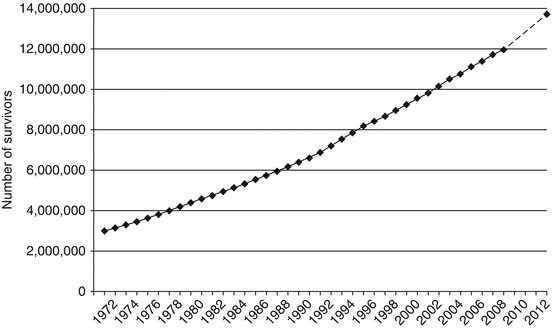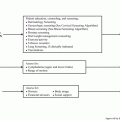and Frances Zandstra2
(1)
Department of Lymphoma and Myeloma, The University of Texas MD Anderson Cancer Center, Houston, TX, USA
(2)
Office of Cancer Survivorship, The University of Texas MD Anderson Cancer Center, Houston, TX, USA
Chapter Overview
The official definition of a cancer survivor encompasses those experiencing the entire trajectory of cancer care, including diagnosis, treatment, and beyond treatment. For each of these three phases, survivors have different health care needs. A report issued in 2005 by the Institute of Medicine, entitled “From Cancer Patient to Cancer Survivor: Lost in Transition,” brought to light the problems that many cancer survivors face once they are past the phase of cancer treatment. Survivors reported they struggled to find health care services and providers in their communities to address their persistent or late-emerging health problems that were secondary to their former cancer diagnosis or effects of treatment. This chapter will describe the process within our institution for developing a multidisciplinary care delivery model, as well as the components of care in the model. The domains of health care that address known and anticipated “after cancer” health care needs of survivors are as follows: surveillance for possible late recurrence of the primary cancer; screening and early detection, as well as prevention, of additional primary cancers; monitoring for and management of persistent or late effects of treatment; and psychosocial health. Communication between the primary oncology teams and community physicians is very important for continuity of care. It is recommended that a summary document be prepared as a care plan for each survivor, detailing the following: type of treatments received; residual and possible future late effects or complications; indicated evaluations for health maintenance; and cancer surveillance/screening.
Introduction: The Cancer Problem
The most current Surveillance Epidemiology and End Results (SEER) projections indicate high lifetime cancer risks for both men and women: 1 in 2 for men and 1 in 3 for women (Howlader et al. 2011). The malignancies for which both men and women are most at risk originate in organs influenced by sex hormones: prostrate carcinoma is the most common cancer in men and breast cancer is the most common cancer in women (Table 2.1). The second most common malignancy is lung cancer, followed by colorectal cancer, in both men and women. These four malignancies (“the big four”) constitute the highest solid tumor burden in the US population. Among hematologic malignancies, lymphomas are the most common, ranking seventh in frequency for both men and women.
Table 2.1
Cancers occurring most often in men and women in the United States in 2012a
Men (848,170 cases); cancer lifetime risk: 1 in 2 | Women (790,740 cases); cancer lifetime risk: 1 in 3 | ||
|---|---|---|---|
Cancer site | Percentage of cases | Cancer site | Percentage of cases |
Prostate | 29 | Breast | 29 |
Lung and bronchus | 14 | Lung and bronchus | 14 |
Colon and rectum | 9 | Colon and rectum | 9 |
Urinary bladder | 7 | Uterine corpus | 6 |
Melanoma (skin) | 5 | Thyroid | 5 |
Kidney and renal, pelvic | 5 | Melanoma (skin) | 4 |
Non-Hodgkin lymphoma | 4 | Non-Hodgkin lymphoma | 4 |
Leukemia | 3 | Kidney and renal, pelvic | 3 |
Oral cavity | 3 | Ovary | 3 |
Pancreas | 3 | Pancreas | 3 |
All other sites | 19 | All other sites | 23 |
Why is cancer survivorship a big concern? Paradoxically, while the total number of cancer-related deaths has increased, so has the number of cancer survivors. A great deal of progress has been made in the treatment of malignant diseases. Among the big four cancers (prostrate, breast, colorectal, and lung carcinomas), the only disease for which significant survival progress has not been made is carcinoma of the lung and bronchus. For the other three malignancies, 5-year survival rates have been increasing since the 1970s (Table 2.2; American Cancer Society 2012).
Table 2.2
Five-year relative overall survival ratesa (%) in the United States, 1975–2007
Site | 1975–1977 | 1984–1986 | 1999–2007 |
|---|---|---|---|
All sites | 50 | 54 | 68 |
Breast (women only) | 75 | 79 | 90 |
Colon | 52 | 59 | 66 |
Leukemia | 35 | 42 | 55 |
Lung and bronchus | 13 | 13 | 16 |
Melanoma | 82 | 87 | 93 |
Non-Hodgkin lymphoma | 48 | 53 | 69 |
Ovary | 37 | 40 | 45 |
Pancreas | 3 | 3 | 6 |
Prostate | 69 | 76 | 100 |
Rectum | 49 | 57 | 69 |
Urinary bladder | 74 | 78 | 81 |
From Cancer Patient to Cancer Survivor
The SEER survival data show that among long-term cancer survivors (those living 5 years or longer beyond the date of their cancer diagnosis), 60% are older than 64 years and approximately 40% are in the working adult age bracket (20–64 years), or those in their productive years of life who are concerned about maintaining employment. It is projected that within the next 40 years the population of long-term cancer survivors aged 65 years or older will double compared with today’s numbers. This is very important because a higher frequency of concurrent illness occurs among survivors aged 65 years or older than among other age groups, and this can significantly influence both the management of cancer and the long-term complications of treatment. Therefore, managing the concurrent health problems of cancer patients and survivors is equally as important as managing the cancer itself.
Patients who reach long-term survivorship status can be well and reintegrate into a normal life. Unfortunately, many cancer survivors do not recover their health and do not receive adequate health care. The Institute of Medicine published a comprehensive assessment of the status of cancer survivors in the United States in 2005. This assessment noted that a significant proportion of survivors suffered from chronic, long-term physical, social, or emotional distress. The study, entitled From Cancer Patient to Cancer Survivor: Lost in Transition, found that a critical issue for many patients was limited access to health care and lack of coordination of their health care once the cancer treatment and intermediate surveillance was concluded (Hewitt et al. 2006). The study made several recommendations for health care providers, as well as for policy-makers and government bodies, to improve the care of survivors. A more recent updated report emphasizes ten additional recommendations (Levit et al. 2013). One of these recommendations is that care must be coordinated and integrate multidisciplinary expertise. At our own institution, we have developed a multidisciplinary care delivery model that incorporates the elements of care outlined in this chapter.
Surviving Cancer
The development of chemotherapeutic regimens as primary or adjunctive treatment for various cancers evolved rapidly in the 1960s and 1970s, as did the application and awareness of early cancer screening. In 1986, the founders of National Coalition for Cancer Survivorship set out to establish an organization that would change the phrase “cancer victim” to “cancer survivor.” To this end, the National Coalition for Cancer Survivorship crafted the definition of a survivor: from the time of diagnosis and for the balance of life. By the early 1990s, there was evidence of a sustained increase in the number of persons diagnosed with cancer who were living 5 years or longer beyond their diagnosis (Fig. 2.1). In 1996, the National Cancer Institute established an Office of Cancer Survivorship (OCS) in response to this trend, as well as in response to the concern that knowledge about the health of cancer survivors and the long-term effects of cancer treatment was significantly lacking. The OCS’s first challenge was answering the question: who is a cancer survivor? The OCS adapted the National Coalition for Cancer Survivorship’s definition of a survivor: “An individual is considered a cancer survivor from the time of diagnosis through the balance of his or her life” (National Cancer Institute 2012). OCS also expanded that definition to include the family and primary caregivers of the patient, because they all are influenced by the experience of cancer. Given the OCS’s very broad definition of who is a cancer survivor, when we speak of survivors’ health care needs we are speaking of a large and changing landscape; the cancer survivor’s journey today can cover a long chronologic trajectory.


Fig. 2.1
Estimated number of cancer survivors in the United States between 1971 and 2012 (Source: American Cancer Society 2012)
Phases of Survivorship
The health care needs of cancer survivors, then, do not remain the same in later phases of survivorship as they were in the early phases of survivorship. The concept of “seasons of survival” was described in 1985 by Fitzhugh Mullan in an article in which he described his personal experience as a physician and a cancer survivor (Mullan 1985). Dr. Mullan described three principally different cancer survival phases, distinct from each other both on an experiential level and from a clinical perspective.
The acute phase begins with the diagnosis of cancer and includes testing for and treatment of the malignancy. Clinical care at this point is principally oncologic (i.e., administered by surgical, radiation, and medical oncologists), with a focus on eradication of the malignancy and management of any acute complications of treatment. From the patient’s perspective, the primary experience is one of illness, treatment side effects, anxiety about the treatment, and fear of the cancer, as well as hope of reaching a remission.
Stay updated, free articles. Join our Telegram channel

Full access? Get Clinical Tree





